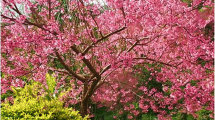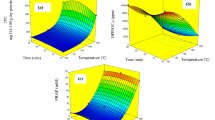Abstract
The antibacterial effect of plant extract majorly depends on the process parameters of herbal extraction. In this aspect, this study is focused on optimizing the extraction conditions for better performance after application. The effects of variables like extraction time, sonication time and the extraction temperature were taken as key parameters. The Box and Behnken design was adopted to study the effects of these parameters on the effectiveness of extraction in terms of the in vitro antibacterial activity of treated textile (in zone of inhibition) against odour-causing bacterial strains. The response surface methodology results showed that the increment in the extraction time from 12 h to 36 h increases the antibacterial activity. The extraction temperature has a very little effect on the efficacy against the selected strains. The increment in the temperature after 39 °C reduces the activity considerably. The effect of sonication time plays a vital role in the dissolvability of the active substance. The regression coefficient values (r2) of 82.27, 80.6, 77.51 and 45.11% are obtained, respectively, for Corynebacterium sp (MTCC 8730), Bacillus licheniformis (MTCC 429), Micrococcus luteus (ATCC 49732) and Corynebacterium acnes (MTCC1951). The optimized extraction parameters for improved antibacterial properties are identified: methanol with 29.1 h of immersion, 30 min of sonication period and 35 °C of extraction temperature. At optimized condition, the zone of inhibition values is predicted as 10.94, 31.87, 24.33 and 40.44 mm, respectively, for the above-mentioned strains.





Similar content being viewed by others
References
Fazal Hina, Ahmad Nisar, Khan Mir Ajab (2011) Physico-chemical, phytochemical evaluation and dpph-scavenging antioxidant potential in medicinal plants used for herbal formulation in Pakistan. Pak J Bot 43:63–67
Thomson GE (2007) The health benefits of traditional chinese plant medicines: weighing the scientific evidence. A report for the rural industries research and development corporation, Australian government, p 44
Handa SS, Khanuja SPS, Longo G, Rakesh DD (2008) Extraction technologies for medicinal and aromatic plants. Int Centre Sci High Technol 29:21–52
Dai Jin, Russell JM (2010) Plant phenolics: extraction, analysis and their antioxidant and anticancer properties. Molecules 15:7313–7352
Chan SW, Lee CY, Yap CF, Wan Aida WM, Ho CW (2009) Optimisation of extraction conditions for phenolic compounds from limau purut (Citrus hystrix) peels. Int Food Res J 16:203–213
Bharathi V, Patterson Jamila, Rajendiran R (2011) Optimization of extraction of phenolic compounds from Avicennia marina (Forssk.) Vierh using response surface methodology. Int J Biol Med Sci 1:1
Liyana-Pathirana C, Shahidi F (2005) Optimization of extraction of phenolic compounds from wheat using response surface methodology. Food Chem 93:47–56
Stevigny C, Rolle L, Valentini N, Zeppa G (2007) Optimization of extraction of phenolic content from hazelnut shell using response surface methodology. J Sci Food Agric 87(15):2817–2822
Xu BJ, Chang SK (2007) A comparative study on phenolic profiles and antioxidant activities oflegumes as affected by extraction solvents. J Food Sci 72:159–166
Ahmad I, Mehmood Z, Mohammad F (1998) Screening of some Indian medicinal plants for their antimicrobial properties. J Ethnopharmacol 62(2):183–193
Eloff JN (1998) Which extract should be used for the screening and isolation of antimicrobial components from plants? J Ethnopharmacol 60:1–8
Prakash CG (2012) Biological and pharmacological properties of Terminalia chebula Retz. (Haritaki)–an overview. Int J Pharm Pharmaceut Sci 4(3):1
Dash B (1991) Materia Medica of Ayurveda. B. Jain Publishers, New Delhi, pp 170–174
Uma DB, Ho CW, Wan Aida WM (2010) Optimization of extraction parameters of total phenolic compounds from Henna (Lawsonia inermis) Leaves. Sains Malaysiana 39(1):119–128
Rathinamoorthy R, Udayakumar S, Thilagavathi G (2011) Antibacterial efficacy analysis of punica granatum l. Leaf, rind and terminalia chebula fruit extract treated cotton fabric against five most common human pathogenic bacteria. Int J Pharm Life Sci 2:1147–1153
Box GEP, Draper NR (1959) A basis for the selection of a response surface design. J Am Stat Assoc 54:622–654
Ran Z, Shufen L, Dacheng Z (2009) Combination of supercritical fluid extraction with ultrasonic extraction for obtaining sex hormones and IGF-1 from Antler Velvet. Chin J Chem Eng 17:373–380
Albu S, Joyce E, Paniwnyk L, Lorimer P, Mason J (2004) Potential for the use of ultrasound in the extraction of antioxidants from Rosmarinus officinalis for the food and pharmaceutical industry. Ultrason Sonochem 11:261–265
Bruni R, Guerrini A, Scalia S, Romagnoli C, Sacchetti G (2002) Rapid techniques for the extraction of vitamin E isomers from Amaranthus caudatus seeds: ultrasonic and supercritical fluid extraction. Phytochem Anal 13:257–261
Wang L, Weller CL (2006) Recent advances in extraction of nutraceuticals from plants. Trends Food Sci Technol 17:300–312
Keil FJ (2007) Modeling of process intensification’. Wiley, KGaA, Weinheim
Morelli LLL, Prado MA (2012) Extraction optimization for antioxidant phenolic compounds in red grape jam using ultrasound with a response surface methodology. Ultrason Sonochem 19:1144–1149
Reuter HD, Koch HP, Lawson LD (1996) Therapeutic effects and applications of garlic and its preparations. In: Koch HP, Lawson LD (eds) Garlic. The science and therapeutic application of Allium sativum L. and related species. Williams & Wilkins: Baltimore, Md, pp 135–212
Sah Pankaj, Al-Tamimi B, Al-Nassri N, Al-Mamari R (2012) Effect of temperature on antibiotic properties of garlic (Allium sativum L.) and ginger (Zingiber officinale Rosc.). Afr J Biotechnol 11(95):16192–16195
Lee Ying Yeng (2013) A comparative study of extraction techniques for maximum recovery of glutamate decarboxylase (GAD) from Aspergillus oryzae NSK. BMC Research Notes 6:526
Ortuño C, Irianda P, Paniagua I, Bon J, Corona E, Benedito J (2010) Effect of supercritical extraction time on the antimicrobial activity of thyme (Thymus Zygis) extracts. In: International conference on food and innovations. Universidad Politechnica de valenica
Enyi-Idoh, Utsalo S, Epoke J, Arikpo G, Eja E (2012) Time-dependent evaluation of the antibacterial and phytochemical properties of vernonia amygdalina and gongronema latifolium. Int J Herbal Plant Med 1(2):1–7
Acknowledgements
The authors acknowledge the Management of PSG College of Technology, Coimbatore, India, for providing necessary facility to perform this research.
Author information
Authors and Affiliations
Corresponding author
Ethics declarations
Conflict of interest
The authors declare that there is no conflict of interest to publish this manuscript.
Additional information
Publisher's Note
Springer Nature remains neutral with regard to jurisdictional claims in published maps and institutional affiliations.
Significance Statement This research optimizes the methanolic extraction process parameters of Terminalia chebula fruit extraction process for improved antibacterial activity against skin born odour causing bacteria through the application on textile fabrics.
Rights and permissions
About this article
Cite this article
Rathinamoorthy, R., Thilagavathi, G. Statistical Optimization of Terminalia chebula Fruit Extraction for Improved Antibacterial Activity Against Odour-Causing Bacteria. Proc. Natl. Acad. Sci., India, Sect. B Biol. Sci. 90, 365–374 (2020). https://doi.org/10.1007/s40011-019-01105-w
Received:
Revised:
Accepted:
Published:
Issue Date:
DOI: https://doi.org/10.1007/s40011-019-01105-w




